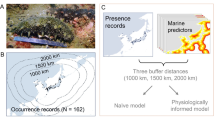Abstract
If we lack data on the biology of rare species, then understanding of the biology of rarity will be incomplete at best, biased at worst. However, the extent of potential under-study is mostly unknown. We therefore ask for primates, one of the better known orders of mammals, whether data are lacking on rare species. The measure used is published data on a crucial aspect of biology, namely density. Rare species are here defined as those with both geographic range sizes and habitat breadths less than the median for primates; common species are at or above the median for those two measures. Globally, nearly half, 47%, of the 32 rare species lack data on their density, compared to only 10% of the 83 common species (χ2corr. = 17.1, p < 0.001). Within realms, Asia and Madagascar show a particularly strong bias, missing density data for over 50% of their rare species. Thus, rare species are indeed severely under-studied compared to common species, even in this well-studied mammalian taxon.
Similar content being viewed by others
References
M.S. Alvard (2000) The impact of traditional subsistence hunting and trapping on prey populations: data from Wana horticulturalists of upland central Sulawesi Indonesia J.G. Robinson E.L. Bennett (Eds) Hunting for Sustainability in Tropical Forests. Columbia University Press New York 214–230
M.G. Chapman (1999) ArticleTitleAre there adequate data to assess how well theories of rarity apply to marine invertebrates? Biodiversity and Conservation 8 1295–1318
G.B. Corbet J.E. Hill (1991) A World List of Mammalian Species Oxford University Press Oxford UK
P. Cotgreave M. Pagel (1997) Predicting and understanding rarity: the comparative approach W.E. Kunin K.J. Gaston (Eds) The Biology of Rarity Chapman & Hall London 237–261
J.M. Diamond (1984) Historic extinctions: a Rosetta Stone for understanding prehistoric extinctions P.S. Martin R.G. Klein (Eds) Quaternary Extinctions. A Prehistoric Revolution The University of Arizona Press Tucson, arizona 824–862
J.M. Diamond (1989) ArticleTitleThe present past and future of human-caused extinctions Philosophical Transactions of the Royal Society of London B 325 469–477
InstitutionalAuthorNameESRI Inc. (1998) ArcView GIS, version 3.1 Environmental Systems Research Institute Redlands, CA
K.J. Gaston (1994) Rarity Chapman & Hall London
K.J. Gaston (1997) What is rarity? W.E. Kunin K.J. Gaston (Eds) The Biology of Rarity Chapman & Hall London 30–47
S.M. Goodman B.D. Patterson (Eds) (1997) Natural Change and Human Impact in Madagascar Smithsonian Institution Press Washington, DC
C.P. Groves (1993) Order primates D.E. Wilson D.M. Reeder (Eds) Mammal Species of the World: A Taxonomic and Geographic Reference Smithsonian Institution Press Washington, DC 243–277
C.P. Groves (2001) Primate Taxonomy Smithsonian Institution Press Washington, DC
I. Hanski J. Kouki A. Halkka (1993) Three explanations of the relationship between distribution and abundance of species R.E. Ricklefs D. Schluter (Eds) Species Diversity in Ecological Communities University of Chicago Press ChicagoIllinois 108–116
A.H. Harcourt (2000) ArticleTitleCoincidence and mismatch in hotspots of primate biodiversity: a worldwide survey Biological Conservation 93 163–175
InstitutionalAuthorNameIUCN (2003) 2003 IUCN Red List of Threatened Species International Union for Conservation of Nature and Natural Resources Gland Switzerland
J. Jernvall P.C. Wright (1998) ArticleTitleDiversity components of impending primate extinctions Proceedings of the National Academy of Sciences.USA 95 11279–11283
C.N. Johnson (1998) ArticleTitleSpecies extinction and the relationship between distribution and abundance Nature 394 272–274
A. Jolly (1986) Lemur survival K. Benirschke (Eds) Primates. The Road to Self-Sustaining Populations Springer-Verlag New York 71–98
D. Rabinowitz S. Cairns T. Dillon (1986) Seven forms of rarity and their frequency in the flora of the British Isles M.E. Soulé (Eds) Conservation Biology. The Science of Scarcity and Diversity Sinauer Associates SunderlandMassachusetts 182–204
A.F. Richard R.E. Dewar (1991) ArticleTitleLemur ecology Annual Review of Ecology and Systematics 22 145–175
N. Rowe (1996) The Pictorial Guide to the Living Primates Pogonias Press East Hampton, Newyork
M.E. Soulé (Eds) (1987) Viable Populations for Conservation Cambridge University Press CambridgeUK
Author information
Authors and Affiliations
Corresponding author
Rights and permissions
About this article
Cite this article
Coppeto, S.A., Harcourt, A.H. Is a biology of rarity in primates yet possible?. Biodivers Conserv 14, 1017–1022 (2005). https://doi.org/10.1007/s10531-004-0668-1
Received:
Accepted:
Issue Date:
DOI: https://doi.org/10.1007/s10531-004-0668-1




